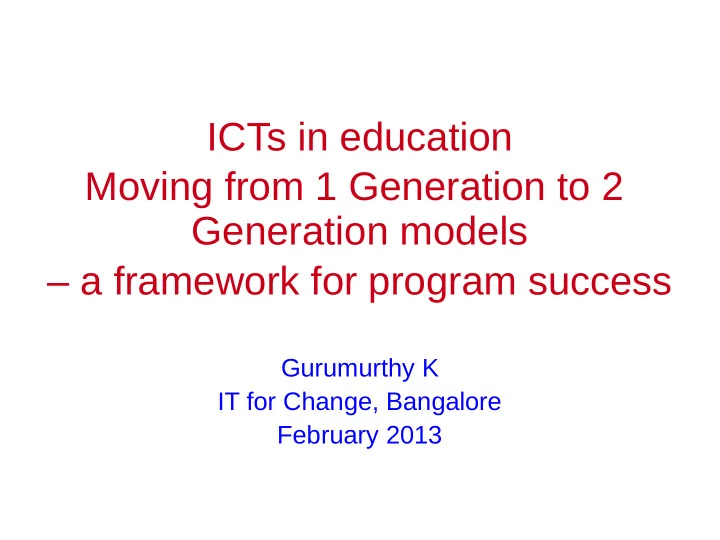

ICTs in education Moving from 1 Generation to 2 Generation models – a framework for program success Gurumurthy K IT for Change, Bangalore February 2013
ICT Models in Business First generation computer applications in business - Simple areas - salaries and accounting. Chief Information Officers designed programs Limited benefits Second generation applications - core business areas – production, supply chain management Driven by business managers to achieve business goals. Provided significant benefits to business
ICT programs in school system First generation ICT programs in school system – use a 'technological perspective' Driven largely by technology vendors or “ICT experts” Of limited benefit / have largely been failures Second generation ICT programs address educational priorities, based on educational policies Designed by people working in core education Teacher Education has been the primary focus of second generation ICT programs, from this new models of TE are emerging
Factor 1 - Curriculum 1G Program stops with providing hardware (and pre-packaged software). Curriculum - basic computer literacy (Windows and MS Office) and pre-packaged content (CD ROMs). Program stand-alone - Teachers do not show interest and engagement with such curriculum 2G program - Curriculum - regular school subjects - Mathematics, Science, Social Science, Languages Curriculum encourages teachers to participate in learning resource material creation – text, educational tools and videos Curriculum integrates ICTs with core education
Factor 2 - Transaction 1G program transacted by computer teachers trained in computer science, not regular school subjects. Program bypasses teachers and goes directly to students through the computer teacher. 2G program – focus on TE Curriculum in the ICT program is transacted by regular teachers Teachers use 3 kinds of digital methods to create learning resources • educational software applications like Geogebra, Freemind, Marble • web tools like wiki, translator • digital tools like video camera (with video editing software) • Teachers teach/train one another
Factor 3 - Public domain First generation program Use of proprietary software and content (owned by vendor) Cannot be shared (increases program costs), cannot be customised (reduces flexibility), cannot be upgraded (license fees) Creates a 'minimalist / poor learning environment' and teacher as consumer (behaviorist approach) Second generation program Use of a large variety of free digital tools/resources (in the public domain) helps move from a 'scarce (minimalist) proprietary digital environment' to a 'rich/diverse public digital environment'. Digital resources are non-rivalrous (sharing does not reduce availability) and hence promoting public creation/sharing of digital resources most important
Its already here IT@Schools (Kerala), USRN (Delhi), Subject Teacher Forum (Karnataka) are examples of 2G programs in schools. High ownership of teachers → use of ICTs in teaching-learning Teachers co-create resources using a variety of digital tools connect to one another and to teacher educators continuously for sharing and learning virtually TE is need based, self directed, collaborative/peer based, mentored and continuous, linking TE institutions to the school
Some thoughts See ICTs as an important and integral pedagogical resource, not a standalone subject National Policy requirements relating to teacher professional development can only be met building on second generation ICT programs Pre-Service – integrate digital tools and methods into curriculum (Karnataka pre-service curriculum revision) Move to need based/cafeteria models of TE that are self-directed, self paced and require/support a learning community of teachers Encourage linkages between schools and support institutions, universities and NGOs
Recommend
More recommend